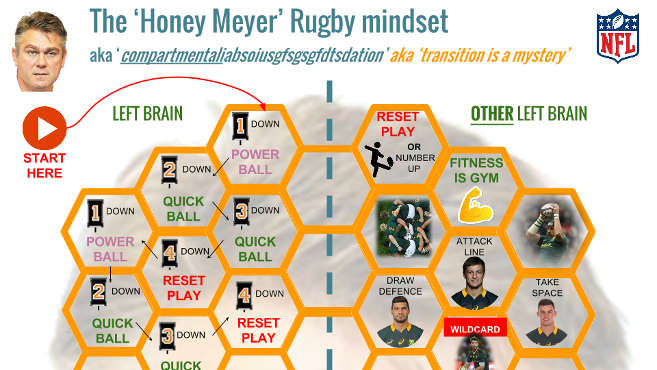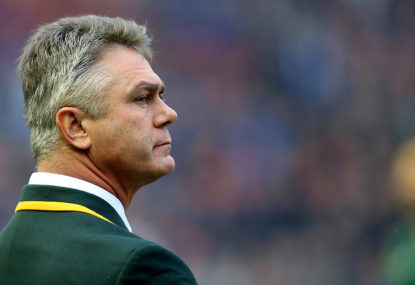Heyneke Meyer wants to play some football. American football.
American football has only one phase. The umpires helicopter their arms. The huddle breaks. Every player trots to an appointed spot. Every man has a duty.
The center snaps to the quarterback, who hands off to a running back. Four yards and a cloud of dust.
They all stand up. The quarterback consults a chart taped to his wrist using a pre-planned sequence or ‘checks off’ a new play brought in by the shuttled player from the hyper-active, vein-popping coach.
There is no second phase. No breakdown. The only semi-chaotic plays occur when the defending team intercepts the ball and runs it back. Tacklers become blockers; a quarterback tries to tackle.
Even kick returns are highly planned orchestras now, with channels, highly-regulated directions, and almost no lateral passes attempted unless the team is down to the last seconds and needs a touchdown.
Gridiron isn’t a simple game; blocking schemes and the ‘vertical’ nature of the forward pass creates a complex chessboard, and a great coach is the MVP. Some coaches are virtual institutions.
Every player is a specialist, like Morne Steyn or Jannie du Plessis. The offensive guard never touches the ball. The punter never throws a pass. The wide receiver only catches. Quade Cooper and Kurtley Beale, if in the NFL, might never have to attempt a tackle.
Heyneke Meyer wants to simplify rugby, control it, zone it, and remove all chaos from the union code. Early in his career, he read a great deal about NFL coach Vince Lombardi and periodically he has visited the US to study gridiron training, camps, tactics, and statistics.
Meyer felt at home with obsessive NFL high-blood pressure manic coaches, who have team psychiatrists, nutritionists, holding coaches, jumping coaches, eyeball coaches.
One of his right hand men, Johann van Graan, coaches the Springbok forwards. This is like being Meyer’s number two because his strategy to win the World Cup revolves around only forward issues: scrum strong to win penalties, win all our lineouts and steal or bother theirs, and pulverise the breakdown area.
Van Graan grew up at Loftus Versveld; his dad ran the Bulls. The Bulls have had the most NFL-style setup in rugby for years: a machine, the best gym, a system with structures.
This is Meyer’s philosophy: everything in a compartment. Compartmentalisation. Which is hard to spell. His coaching mantra is compartmentaliabsoiusgfsgsgfdtsdation.

He noticed that the NFL keeps everything in compartments, too. So, he and van Graan have made annual pilgrimages to NFL pre-season camps, and try to adapt rugby to the NFL compartments.
Meyer and ‘Aap’ van Graan are like minded: they love stats, they love to watch rugby video, rewinding and stopping and pausing and playing – just like NFL coaches.
Meyer calls van Graan, who has previously lived in the US, his best selection ever, player or coach.
“When I appointed him, nobody knew who he was,“ says Meyer. “For one, because he came with no baggage, no background and secondly the way he grew in the position.”
Meyer likes to build a structure. He wants things in compartments.
To understand Meyer’s compartments it is necessary to look at each facet of play as a compartment. The Scrum, the line out, the breakdown, the restart, are constituent parts, just percentages of the eighty minutes.
But Meyer dreams of breaking every facet down into action items susceptible to measurements by van Graan. In this paradigm, the breakdown is a set piece. Rugby as Moneyball; specialists at every position, except the bench (bench specialists?).

So how does this translate into 2015?
Every set phase relies upon execution. For the ‘breakdown set piece’ Meyer has Bismarck du Plessis, Francois Louw and Duane Vermeulen. In his mind South Africa has the best pilfering pack in the business, and it isn’t hard to see why.
Pilfering is no longer about one blindside going to the ball on the ground, it is about a collective, and that is where the Springboks have it over other teams.
The Scrum is an area where the Springboks won’t dominate some teams, but Meyer believes his front row is good enough to gain parity against everyone.
The two areas of weakness in 2012 were line outs and restarts. That is where the selection of Victor Matfield came in. If you think Meyer isn’t aware of the liability Victor is outside of these two facets, you are wrong. He was going to use Pieter-Steph du Toit as a Matfield protégée, but the young phemom has struggled to stay healthy.
Heyneke Meyer sees the maul as crucial in the Rugby World Cup. So does every coach. But Meyer won’t maul as much as some, because Meyer detests outcomes that are uncertain and referees are wildly inconsistent about maul defence. The Boks lost to Ireland because Meyer couldn’t compartmentalise the maul.
When we initially looked at the compartmentalisation by Meyer we thought he was completely ignoring the fact that set piece is literally only 20 per cent of a match.
After much debate, to and fro-ing, we eventually figured out that this is where the NFL really comes into play.
According to statistics once you go past the fourth phase of rugby, your chances of scoring diminishes significantly in rugby. You’ve heard this doctrine described by many coaches as ‘playing too much rugby’.
The transition that takes place where the offensive team leaves and the defensive team comes on is usually accompanied with lots of statistical analysis by the commentators.
Meyer loves structure. He is famously chaos averse. Putting structure around the breakdown and transforming it into a ‘set piece’ is the embodiment of that neurosis.
But this is where the four down principle makes no sense in rugby. Once the set piece is completed, you have wild and crazy phase ball; how do you maintain control in phase play?
The beehive Honey Meyer theory is rather simple when you think about it.
The Springboks use every fourth phase as a ‘Fourth Down’, meaning they have the option to kick, and turn over possession, or alternatively they ‘reset’ to first phase.
Consider what happens with fast ruck ball. You can play phase upon phase of quick ruck ball and hope your support runners are in place, they are running onto the ball and into continuing the momentum.
But by the umpteenth phase you will have lost momentum. And this is where the fourth down is used to reset play.
Play is slowed down.
A thinking scrumhalf like du Preez or Pienaar at the base of the ruck waits for his players to get into ‘set piece’ position, and then the phase play is restarted.
Three quick phases, then reset phase, three quick phases, then reset phase.
This is however not where the compartmentalisation ends. Each player is ticked according to a skillset and their key performance indicators.
Pienaar resets the downs, he decides when it is necessary to kick or run the ball down the line.
Handré Pollard attacks the line flat. Damian de Allende draws defenders. Jesse Kriel finds space and accelerates into that space.
Willie le Roux is the talisman, the quarterback used to create space. His skills to create hesitation in defensive structures to create space is well known.
The wingers are there to finish; and also chase kicks as if those kicks are long quarterback 50-50 passes to wide receivers running routes.
The goal kicking is crucial to Meyer, hence the back up selection of Morne Steyn. Pollard can be inconsistent, and Steyn is there as insurance, nothing else.
The one area where Meyer’s compartmentalisation does not make sense is the transition in rugby from attack to defensive mode in the case of turnovers.
American gridiron has four downs in which a team has to make 10 yards. If at the fourth down you have not made your ten yards, you punt the ball from the set piece and play ends. A turnover in the NFL immediately causes the coach to scream to the defensive players to ‘get down!’ Specialists.
In rugby a turnover is immediate, there is no break in play, and good teams exploit turnovers immediately. South Africa have struggled to transition their play from attack to defence, New Zealand in particular have exploited this well.
This analysis is Meyer in a nutshell, maintain control of the set piece, when the game is running away, reset the control, start again.
Every compartment is there for a reason, from each facet of play, right through to the skills of each required player, if necessary, accommodation is made for player weaknesses.
All to ensure the execution of each compartment can perfected.
There are a few questions remaining, something that could not be established or reasoned out.
How do you compartmentalise the transition from attack to defence in the blink of an eye?
When structure is the core value of your game plan, at what point do the players have freedom in decision making?
Does quick ruck ball become “play what is in front of you”?
We know Meyer experimented in 2015, we know that much, but what he experimented with remains a mystery.
Co-authored by Roar regular Biltongbek. Art by RobC































































































